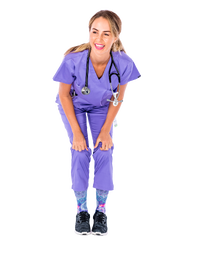FLAT FEET, OVER-PRONATION & FALLEN ARCHES

Less than 5% of the population has flat feet. Having said that, an estimated 60-70% of the Australian population does suffer from “fallen arches” and rolling inward of the foot and ankle. The medical term for this common condition “excessive pronation” or over-pronation.
What does over-pronation look like?
In a seated position, an over-pronating foot appears quite normal. I.e. there’s a clear arch (or instep) visible under the foot. However, when we get up and weight bearing comes into play the situation changes. When we stand up step the arches collapse and the ankles roll inwards.
Pronation vs over-pronation
It is important to note that pronation is not bad for you. Our feet need to pronate and ‘supinate’ to achieve proper gait. Pronation (rolling inwards) absorbs shock and supination (rolling outwards) propels our feet forward. Over-pronation is a pronation movement that goes too deep and lasts for too long, which hinders the foot from recovering and supinating, disrupting our natural gait.
With every step you take, over-pronation impedes your natural walking pattern, causing an imbalance increasing wear and tear of muscles, joints and ligaments. A poor walking pattern caused by over-pronating feet is often the source of common complaints including heel pain, knee pain - even low back pain.
Why do my feet over-pronate and what are the consequences?
There is a strong genetic predisposition for excess pronation. Beyond this, obesity, pregnancy, age, the job you’re in and footwear also play a role in over-pronation. Nurses are no exception. With long hours of standing and walking on hard surfaces, wearing unsupportive footwear will ultimately result in a wide range of possible injuries and complaints, including:
• tired, aching feet
• pain in the ball of the foot (Metatarsalgia)
• heel pain (Plantar Fasciitis)
• Achilles Tendonitis
• excess callous formation
• shin pain
• tired, aching legs
• knee pain
• low back pain
How to prevent over-pronation
Excessive pronation is best treated with foot orthotics. For some people this means going to see a podiatrist and having custom-fitted orthotics fitted. However, for most of us a simple ‘over-the-counter’ orthotic such as Footlogics can be very effective. And much cheaper!
Footlogics orthotics correct over-pronation and promote excellent biomechanical support, thereby providing a sustainable, natural way of preventing and treating common complaints associated with excess pronation.
It is a myth that the more money you spend on a shoe, the better they are for you. It’s not about the amount of cushioning a shoe provide, but rather the ankle stability and support. A low-cost shoe with a strong heel counter and firm orthotic inside will be a lot more beneficial than an expensive, cushioning shoe without an orthotic!
People of all ages can suffer from flat feet. However, the term Òflat feetÓ is often misused because in actual fact very few of us have a truly flat foot. A flat foot has no arch, meaning that the underside of the foot lies completely flat on the ground, whether the person is seated or standing upright.




